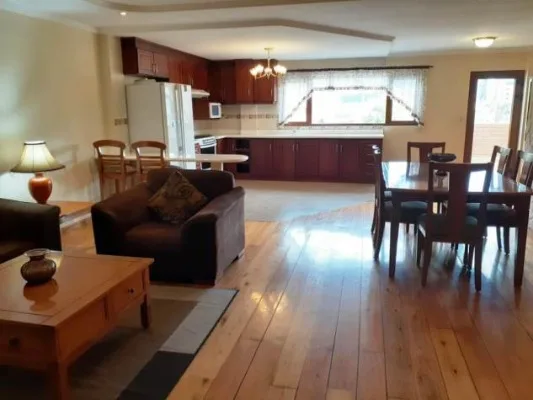Earthquake recovery, with help from expats, brings hope and big changes to Canoa
Text and photos by John Keeble
There is an air of hope and optimism in Canoa, the green shoots of new life breaking through the trauma and sorrow from last year’s earthquake. Much still needs to be done before the people and the area are back on their feet but the signs are good. And some local people and volunteers are talking of more than restoration: they want it to be even better than before the disaster.

On the earthquake anniversary, a pledge to keep helping.
About 75% of this coastal resort village’s buildings – from very humble homes to sturdy hotels – were so badly damaged that they had to be demolished. Visitors can see the gaps in the streets. But only the local people can see the gaps in their families and community.
No one seems to agree on exactly how many died here: the government figure is under 100 but some local figures are over 200. But the effect has been great and, on the first anniversary of the quake, the village was quiet as many people chose to mourn in private.
On the seafront, it was a different story. The anniversary coincided with the Easter holiday weekend and visitors filled the beach and businesses. For those working in tourism, there was no time to look back: the all-too-brief flowering of business had to be harvested as effectively as possible. On the next working day, the tourists had gone and the beach was almost empty.
The government project to provide new homes went on through the holiday, and the easy beach days for some offered no respite to the families still living in tents on the outskirts of the village. Their futures lie mostly with volunteer and government efforts reinforcing their own determination and work.
For the lucky, the earthquake recovery is bringing beneficial change: some of the “most marginalized of the marginal people” are getting chances they would never have been given without the influx of aid; and some of the darker aspects of the old culture are being pushed out by the people, as they experience the new values and attitudes of people from outside the area.
Rubi Valeria Vera Cusme is an example of the earthquake changing life expectations and bringing opportunities. She was among the hopelessly marginalized people given a “tent” home in Proyecto Saman’s emergency camp, organized and built mostly through the efforts of Ecuadorians and expats from Cuenca. Now, a year later, she is rising to what was once an impossible dream: she is moving into her own home. And she has a hope for the future: to open a restaurant. “It is not just a dream,” she said. “I can do it.”

Sarah Hanen Bauer, a Proyecto Saman coordinator.
Sarah Hanen Bauer, one of the Proyecto Saman coordinators, commented: “It is easy to feel sorry for the people here. They don’t want that – but they can do with a hand to help them achieve their new lives.
“The earthquake was a disaster, but for some, like the most marginalized of the marginal people, it has been a chance for a better life. It has given them opportunities they would not have had.”
While most people now have some kind of effective shelter, from tents to houses, many do not have jobs to sustain a good way of life, said Diego San Jose, owner of the Restaurante Amalur, which recently reopened after being used by NGOs and others working on disaster relief.
He said the village can grow again, perhaps in better ways, if it is managed well with good community services, including sewerage and trash removal.
Local people work on the land or the sea as well as in the tourist sector, which is picking up again. San Jose’s own business has seen some recovery and he now expects to average bookings of about 50 per cent of capacity compared with between 80 and 100 per cent before the earthquake.
Proyecto Saman – named after a sheltering tree indigenous to the area – opened its emergency shelter less than a month after the earthquake. The project originated in Cuenca and quickly drew on the generosity, organizational abilities, and sheer determination of a cross-section of expats and Ecuadorians in the city. The team got a big boost from a disaster relief specialist, Sara Coppler, and the free legal work by Cuenca’s INTI corporation.

Daily life at Camp Saman.
“The support from Cuenca has been fundamental to what we have been able to do,” said Coppler, who moved from Cuenca to Canoa to give her knowledge to the project.
First Proyecto Saman efforts focused on getting food and water into the wrecked areas; and then the longer-term relief project began. The project’s social issues coordinator, Diana Moscoso, toured the village asking what people wanted and trying to match them with what was possible in the planned emergency camp.
“The first people who came to us were desperate,” said Hanen Bauer. “They had been living by the side of the road under anything they could find. They were tired, hungry and dirty. They had no security from people out stealing.”
At the height of the project, 36 families – 120 people in total – were being housed at Camp Saman, built on land provided by professional surfer Eddie Salazar. When Cusme moves into her new home, 16 families will still be living at the camp.
“Some families left the camp because they found work in other areas and moved away, some got government help with repairing their homes, some went to live with their families,” said Hanen Bauer.

Main street at Camp Saman.
Most of those remaining have decided to go into the future together. Proyecto Saman – under the organizational umbrella of the Cuenca group Colectivo Madre Tierra – has negotiated an interest-free deal to buy land and build houses for 12 families. The project is being designed by the 12 families, including Hanen Bauer. They are deciding together on the layout, with a communal area and private homes, and they are writing the ‘rules’ by which they want to live together.
This is another example of people being given enough of a helping hand to be able to build new lives that would have been impossible before the earthquake.
Throughout the world, media coverage focuses first on the tragedy, but it is population and cultural change that can be the long-term effect in any disaster area. Canoa is seeing some of this organic process: new opportunities for some leading them into new positions in the community; population changes with some going and others coming in; and once-accepted social ills like domestic violence now being questioned and rejected by some local people.
For outsiders, however desperately needed after the earthquake, it was always vital to see what local people wanted.
“Right from the beginning, we listened to what local people wanted,” said Hanen Bauer. “We managed to get the first part of our camp open in a month and we took people who were desperate.
“We built a community that made all its own rules. The only rule we made was that no one would be allowed to stay if they were violent. We came in a disaster but some disasters had been happening for generations – domestic violence, for example.
“At first, when there were incidents of domestic violence, neighbors in the camp – even women victims – said they didn’t like it but that we should not interfere: it was a matter for the family. But over the months, everyone began to agree that it was not acceptable and the culture changed against those who were violent.”
Proyecto Saman brought in psychologists and therapists to help the people and determine what they wanted and how best to help them build a good future. The outcome included vocational classes, including one on vehicle engineering that is leading to a certificated qualification.
It has also been working with a widening group of specialists, including many departments at the University of Azuay, and with Engineers Without Borders in Germany.
Successful interventions have included helping people start businesses by providing either labor or equipment to get them started. A current project in the village center: a kiosk that will soon be selling fast food. The family got the recycled materials, and the project built the kiosk.
After the first rush of help, most volunteer operations pulled out. But Proyecto Saman is in for the long haul. Its volunteers have become part of local life and have no intentions of leaving.
But they still need more funds and volunteers. “We are very pleased to welcome anyone who wants to help with a donation or time,” said Hanen Bauer.
You can find out more about Proyecto Saman or donate at www.proyectosaman.com
















